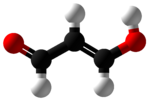
| |||
| |||
| Names | |||
|---|---|---|---|
| IUPAC name
propanedial
| |||
| Other names
Malonic aldehyde; Malonodialdehyde; Propanedial; 1,3-Propanedial ; Malonaldehyde ; Malonyldialdehyde
| |||
| Identifiers | |||
3D model (JSmol)
|
| ||
| Abbreviations | MDA | ||
| ChemSpider | |||
| KEGG | |||
PubChem CID
|
|||
| UNII | |||
CompTox Dashboard (EPA)
|
|||
| |||
| |||
| Properties | |||
| C3H4O2 | |||
| Molar mass | 72.063 g·mol−1 | ||
| Appearance | Needle-like solid[1] | ||
| Density | 0.991 g/mL | ||
| Melting point | 72 °C (162 °F; 345 K) | ||
| Boiling point | 108 °C (226 °F; 381 K) | ||
| Hazards | |||
| NIOSH (US health exposure limits): | |||
PEL (Permissible)
|
none[1] | ||
REL (Recommended)
|
Ca[1] | ||
IDLH (Immediate danger)
|
Ca [N.D.][1] | ||
| Related compounds | |||
Related alkenals
|
Glucic acid | ||
Except where otherwise noted, data are given for materials in their standard state (at 25 °C [77 °F], 100 kPa).
| |||
Malondialdehyde belong to the class of β-dicarbonyls. A colorless liquid, malondialdehyde is a highly reactive compound that occurs as the enol.[2] It is a physiological metabolite, and a marker for oxidative stress.

